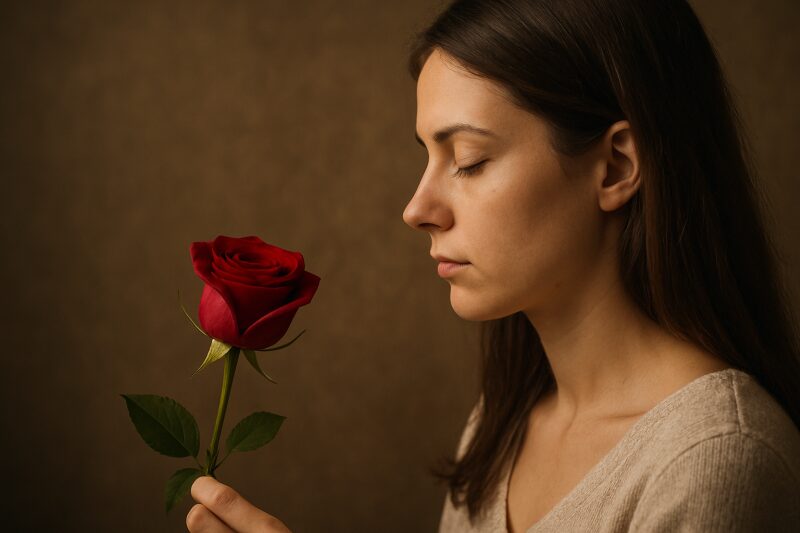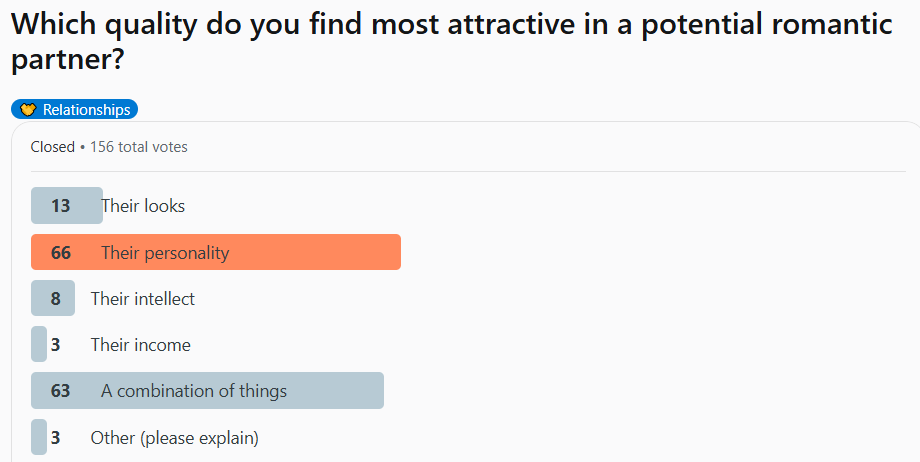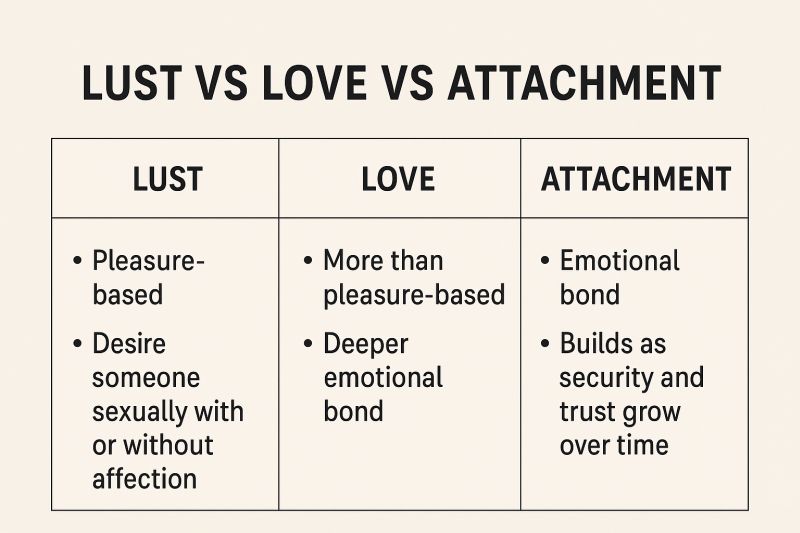- Why Am I Attracted to Someone or in Love?
- What the Research Behind the Psychology of Attraction Says
- How Attraction Works: Psychological and Intellectual Biases
- How Do I Know Why I Am Attracted to Someone for the Wrong Reasons?
- How Do You Tell the Difference Between "False Attraction" and a Real Connection?
- Expert Voices: How Do You Tell if an Attraction is Just Lust?
- Mapping Your Psychology of Attraction: Questions to Ask
- Tools for Exploring Sensuality and Redirecting Limerence
While considering the psychology of attraction, I used to wonder, “Why am I attracted to narcissistic men?” In the afterglow of the sparks I’d feel when they arrived, I’d recall when they showed interest in my hopes and dreams, like when my lover would read my latest article. His compliments about my writing made me blush.

But I’d ignore the red flags: the sudden visits and the silence when I followed up, which I complied with to give them “space” — but made me jittery.
Why was I attracted to these men who vanished, only to return when they craved attention? Later, I saw the psychology of attraction in my life: childhood neglect, abandonment and trauma from my father’s death, and low self-esteem that pulled me to connections I couldn’t hold.
If you’re drawn to a familiar “type,” like I was, you can question whether these patterns help or hurt you. By understanding the psychology of love and attraction — what hooks you and why — you can learn to choose more wisely. Here’s how.
Why Am I Attracted to Someone or in Love?
Based on our wiring and experiences, we can like someone for their looks, their personality, shared interests, or intelligence. Sometimes an emotional connection — how you feel around them — adds to the pull.
Questions to ask yourself to solve the mystery:
- Is my attraction rooted in my childhood? Your attachment style could yield some clues.
- Am I subconsciously picking partners who remind me of my parents?
- Do I keep choosing the same “type” (like narcissists)?
For me, only one connection was on an intellectual level, and seemed to truly be interested in me, mostly because I took the time to try to get to know them. The red flags, however, surrounding their mixed messages gave me pause; I talked myself out of my feelings because their actions spoke louder than their words.
Research into the psychology of attraction supports the idea that the more subtle signs of intellectual or emotional attraction predict longer-term compatibility: How someone listens and follows up (if they do) says a lot about them.
What the Research Behind the Psychology of Attraction Says
In an informal poll of 156 Reddit users, I asked, “Which quality do you find most attractive in a potential romantic partner?” Sixty-six percent chose “personality.” The second most popular answer was “A combination of things,” at 63 percent.
A 2017 YouGov study of people from 20 different countries found men and women ranked personality higher than good looks.

Research shows that appearance and intellect can be more attractive to people who seek short-term relationships.
But for long-term compatibility, a shared lifestyle, opinions, or morals matter more. Men can also consider shared emotions and activities more, while women can value similarities in lifestyle, opinions, morals, conformity, appearance, and empathy. Traditionally, women have been more selective.
How Attraction Works: Psychological and Intellectual Biases
If you’ve ever asked, “Why am I attracted to them,” a few simple biases can explain it.
Shared beliefs, values, interests, and traits like shyness or warmth predispose us to like someone.

When we find someone attractive, we can fall under the spell of the halo effect. In the early stages of attraction, a smile and eyes that sparkle can blind us from seeing the whole picture.
Also, we tend to like people who like us, responding to verbal or nonverbal cues. For instance, someone who smiles at you warmly or who mirrors your gestures or wording can appeal to you; on a more subtle level, when someone looks at you and the centers of their eyes become enlarged or dilated, it’s an unconscious sign of interest.
We can also be more attracted to people who touch us gently, compliment us, or listen actively, which builds safety and trust. Whether it’s lust or love, hormones can play a role behind the scenes.
When we’re aroused, the hypothalamus and amygdala in our brains light up, releasing chemicals like testosterone, estrogen, dopamine, and norepinephrine that fuel desire and excitement.
Dopamine activates the brain’s reward circuitry, creating feelings of pleasure and euphoria. Testosterone and estrogen control sexual desire, while norepinephrine contributes to physical signs of excitement like alertness and an increased heart rate.
Brain chemicals also influence attraction to someone based on a shared experience. In misattribution of arousal, people see their bodily reactions (like a racing heart or an adrenaline rush) as attraction rather than linking them to their fears or excitement over the situation — like when a couple watches a scary movie together
Example: In the Capilano Suspension Bridge Study, people were more attracted to someone they met on a shaky suspension bridge compared to when they met them on a more stable one.
The researchers credited this difference to the context: the men who were approached on the suspension bridge were already nervous, with high heart rates, dizziness, or sweaty palms — the same as signs of attraction.
Post-Nut Clarity: Beyond the Afterglow
Post-nut clarity is a feeling some people experience after an orgasm when they regain the reason or insight clouded by lust.
After arousal, dopamine drops, prolactin rises, and oxytocin — the bonding hormone — is released, influencing emotional connection.
The blood flow in the prefrontal cortex — the part of the brain that reasons and makes decisions — reduces during arousal. But it’s restored post-orgasm, which opens the path to clearer, more rational thinking. That’s why people sometimes describe a sudden shift after sex from “I can’t live without them” to “What was I thinking?”
Post-nut syndrome can also occur after climax, leading to emotions beyond guilt, like happiness or euphoria or crying or depression. If they’re intense, consider seeking professional help.
How Do I Know Why I Am Attracted to Someone for the Wrong Reasons?
Looking at your love map yields clues about your attraction patterns — what you learned and didn’t learn from past crushes or relationships.
When you reflect on them, consider what attracted you the most. That can guide you toward what to focus on.
Questions to Ask:
- Which traits that drew you in were healthy?
- Was the attraction based more on looks than on personality or compatibility?
- Was it based on how the person treated you?
Kindness is an attractive quality, as is empathy. If we think someone possesses a rare trait, like emotional intelligence, they can also seem more desirable and special.
In the first phases of attraction, I’ve often focused more on looks or “sparks” than on compatibility. That’s normal, but the psychology of love and attraction often remind us it’s in our best interest to dig deeper. Looks-based attraction is often lustful, which is when hormones like dopamine and oxytocin kick in and can blind you — look before you commit.
I’ve shown a pattern of attraction to narcissistic types; these men shared some of the traits of narcissistic personality disorder.
Example: After my lover arrived unexpectedly with the flowers he’d missed on Valentine’s Day, I said “thanks,” hoping our relationship would improve. When I discussed things like not receiving bouquets on important days, he’d say he couldn’t be changed.
Every time we made progress, he retreated or strung me along, acting like we would be in a real relationship, and at other times telling me he didn’t love me.
The flowers and surprise visits felt like rewards; his pulling away left me longing for more.
The reactive gestures and the hurtful comments are consistent with narcissistic patterns like intermittent reinforcement and devaluation — giving occasional praise or attention, then withdrawing it to control and confuse their targets.
Not everyone meets the clinical definition of narcissism. When you’re attracted to these types, it can be tough to determine if you’re seeing reality or if the attraction stems from your baggage.
Narcissists project charm and confidence, which can feel exciting and uplifting, especially for those who seek validation or a rescue from emotional pain. The attraction often centers on a mix of unconscious needs, emotional vulnerabilities, and the narcissist’s manipulations to achieve their desires for admiration and control.
Sensitive and caring empaths are drawn to narcissists who seek their attention and admiration (also known as “fuel” or “supply”). People with weak boundaries or co-dependent tendencies can also be more vulnerable to exploitation by narcissists.
For instance, people who had narcissistic or emotionally neglectful parents might gravitate to narcissistic partners because their behavior feels familiar or supports their beliefs about love and relationships.
Discover if You’re an Authentic Dater – Free Quiz
How Do You Tell the Difference Between “False Attraction” and a Real Connection?
Beyond looks, personality, and other factors, our insecurities can affect who we’re drawn to — that’s not a healthy basis for attraction. When I was in a toxic relationship, both of us struggled to follow through with our breakup, though it was the right choice.
Knowing why you’re attracted to someone helps you see if it mirrors old wounds or if there’s a real connection.
Questions to ask:
- Is it surface-level, or do I really know the person?
- Is there a solid basis for my feelings, or is something from my past triggering them?
- When I fantasize about the person, do I still feel attracted to them?
- Does the attraction bring me joy, or do I feel anxious or drained?
Western media like movies and music emphasize lust-based attraction. Attraction based on love goes deeper. To separate lust from love, get in touch with your feelings. A lust or crush-based attraction is more of an obsession. During this lack of focus or dysregulation, you can stop paying attention to what’s happening around you, like losing track of time.
Example: When someone with an anxious attachment style gets attention from an avoidant partner, they can feel ecstatic. But when the avoidant person withdraws, the effect wears off. The anxious person could be prone to “love OCD,” ruminating over potential conflicts or losses. This almost conditioned response might lead them to confuse the obsessive thoughts with love.
Use the psychology about attraction to check your motives. If the attraction doesn’t bring you joy or feel safe, think twice before you get deeply involved, which can save you some heartache.
Mapping Your Psychology of Attraction: Questions to Ask
Is This a Real Connection? Checklist
Tick if true. 4+ true = promising; 2 or fewer = proceed with caution.
- They listen and remember details about me.
- They treat others kindly, not just me.
- I can disagree with them without fearing big emotional swings.
- Their goals and values don’t clash with mine.
- I want to be with them on a rainy Tuesday when I’m OK with being alone.
Journal Prompts
Use before you enter a relationship.
- What do I feel when I’m with them: safe or excited? Describe the sensations.
- What patterns from my childhood does this remind me of?
- If this relationship ended tomorrow, what would I regret or miss and why?
- Would I want to be friends with this person if I wasn’t physically attracted to them?
Over time, crushes can become addictive, leading to limerance or unrequited love, an attachment to someone who can’t return the affection. The uncertainty of limerance can fuel obsessive thoughts and lust. If you feel emotions intensely, this can be unhealthy, especially if — even after releasing your feelings through gratification like masturbation — you feel depressed because day-to-day life differs from the fantasy.
Tools for Exploring Sensuality and Redirecting Limerence
If you ask, “Why am I attracted to someone,” and find yourself stuck in limerence, cognitive behavioral therapy has been found to be a successful treatment.
Whatever your level of lust, beyond masturbation, redirecting intense feelings into other pleasurable activities can clear your head, like:
- Enjoying a flavorful meal
- Visiting or talking to loved ones
- Having an intellectually or emotionally stimulating conversation
- Going to a concert or another live event
- Taking a vacation for a change of scene or a short trip to an exotic locale
- Savoring small wonders like the scent of a rose growing in a garden
Especially if you’re working through trauma or other psychological issues, it can be harder to separate lust from love. To see an attraction more clearly, consider traits you prefer in an ideal partner to assess compatibility.
Crushes aren’t always a bad thing; they can be harmless fun that provides a break from a hum-drum routine. If you spot patterns in the positive traits that draw you to someone, use them to decide what to look for in potential partners. You can then use those traits to create an archetype for manifesting your ideal partner.
Psychology of Attraction Key Takeaways
- Spot the patterns: Notice if you’re drawn to a familiar “type” and ask why.
- Look beyond sparks: Attraction based on looks or fleeting attention might not serve you.
- Pay attention to behaviors: How someone treats you consistently matters more than occasional gestures.
- Reflect on past influences: Childhood trauma, low self-esteem, or your attachment style can shape attraction.
- Separate lust from love: Long-term compatibility grows from shared values, trust, and curiosity about each other.
- Take practical steps: Use journaling, self-reflection, and boundary-setting to guide healthier choices.
Which qualities do you find attractive — or look for in a potential partner? We’ll dig deeper into the ingredients to add to your recipe for compatibility later.
In the meantime, check if you’re showing up as your true self or dating in disguise.
- Why Do People Self-Sabotage in Relationships? - December 19, 2025
- “Just Be Yourself” Dating: 3 Barriers to Overcome - November 19, 2025
- Dating With Intention: Exploring Love Compatibility and Chemistry - October 17, 2025